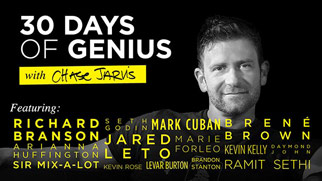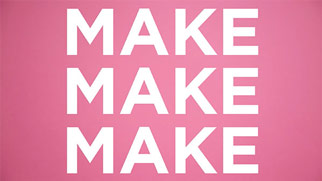When I saw this recent post strike a nerve, it motivated me to share this post from my man Ramit Sethi on charging what you’re worth.
Today he’s back by popular demand to share a simple one-two approach to setting your prices and upping your earning potential.
Pencils ready? Okay, take it away Ramit.
I recently asked a photographer how she came up with her pricing. She said, “Well… I researched my competition and found that they had similar services, so I charged what they were charging.”
Does that sound familiar? Or worse, do you know people who charge less to “undercut” the competition or “get more business?
Here’s the problem with using “me-too” pricing: You’re signaling to your potential clients that you’re the same as everyone else. Why would they choose you when they can always find someone else charging $10 less?
How can some photographers charge 5x, 10x, even 100x what others do? Are they 100x more talented? Do they have 100x more experience? 100x better equipment?
No! The reason they can charge more is simple: Of course they’re good, but good isn’t enough. They’ve learned to position their services as a premium product. Today, I’ll show you how you can, too.
Step 1: Think like your client
Start by asking yourself, “What are my client’s top 3 problems? What are their concerns when hiring a photographer?” The equipment you use probably isn’t in their top 100 problems.
Clients care about themselves and their problems. By taking the time to make your proposal client-focused, you’re already ahead of 90% of your competition.
In an 90-minute interview I did with Chase, we cover tons of examples on how to use this idea. See the 24:00 minute mark where I share exactly how to “read their mind” using a simple technique you can do in the next 5 minutes.
Once you’re in your client’s head and can address their burning needs, price becomes a mere triviality.
THIS is how some creative people can charge 2x, 5x, even 20x what others charge. Yes, they’ve honed their skills, but being good isn’t enough. They know how to focus on their clients, not just their equipment.
Step 2: Use these words to say “no” to low-value clients
One key is learning how to be confident in your own value. Part of getting paid more is believing you’re actually worth more and saying NO to low-paying jobs. Sometimes, we feel grateful for ANY job, especially when we love what we do. This leads to accepting less than you know you’re worth.
The truth is, you’ll get more clients and better clients who respect and value what you do if you’re confident and stick to your rates. Check out this tested word-for-word script to see what I mean:
CLIENT: “What’s your hourly rate?”
YOU: “I’ve actually changed my business so I only do weekly engagements now. This helps me deliver more in-depth results (for example, helping a recent client do ____). The rate for that is $X per week, and that includes A, B, and C.”
CLIENT: “Can’t we just get you for a few hours?”
YOU: “Unfortunately not. I’d love to help but I focus on high-value projects, and those typically take a minimum of a week to understand and execute. The good news is I’ve never had a client who wasn’t happy with the results, even if they originally wanted me for just a few hours. And based on everything you’ve told me, we definitely have more than enough work to keep ourselves busy during that timeframe. The potential upside of Project X is very large.”
CLIENT: “OK, fine. Um… could you do $Y per week instead?”
YOU: “I typically don’t discount my rates except in special cases. If $Y is your budget, I’d be willing do it only if we were to remove either B or C from the project scope. Which would you prefer?”
CLIENT: “Never mind, we can do $X.”
YOU: “Great! I’ll follow up with you soon with next steps.”
Do you see what happened there? Many of us fear we’ll scare away clients by charging premium prices. In fact, low prices are a bigger red flag in your clients mind. Sticking to your higher rate communicates that you’re more valuable than the competition, so the client will lean toward hiring you.
You can even add value to your current clients while raising your rates. The key is to create a win-win situation for you and the client.
Check out this video on how to raise your rates and thrill the client, including a word-for-word script you can use when telling your client about the new rate. You’ll learn:
- 1:00 — The 3 things you must tell your clients about a rate change
- 2:07 — How to get clients excited about the upcoming changes (even if it includes a rate increase)
- 2:30 — A simple way to ensure your clients love you, even if you have to part ways
So how did a graphic designer convince me to pay more? Instead of focusing on design-specific concerns like typography and alignment, he nailed my primary concerns as a client. Click here to find out exactly what those were in an interview I did on pricing here.
—————————————
For more information and help with negotiating your rates and navigating the ins and outs of creative business, check out Ramit’s CreativeLive course, Money + Business For Creatives. Make sure also to check out Ted Leonhardt‘s course on Negotiation for Creatives, Ann Rea‘s course Make Money Making Art, and CreativeLive’s entire catalog of business courses for creatives.





























Great article and video!! Thanks Chase and Ramit:-) I love Ramit’s response to the teacher’s question in the video because as photographers, many of us are heart-centered and we want everyone to have beautiful photographs. Many photographers also feel as if they are failing people if they can’t help everyone. It is freeing as a business owner to realize that everyone isn’t going to be your customer and THAT IS OKAY! Someone else may be a better fit. It is easy in this economy to try to be cheaper or to be the same as the competition but when most industries compete with cheap, as photographers, WE COMPETE WITH FREE! Think about it. Everyone has a digital camera. So, we have to consistently be working to create value so that we can charge what we are worth! Great video:-)
Sarah Petty, co-author of Worth Every Penny, Build a Business That Thrills Your Customers and Still Charge What You’re Worth and owner of the photography marketing educational company, Joy of Marketing
It would be great if I could get to the point where I could actually have this conversation with my clients concerning pricing. Where I live in Singapore, most clients will price shop all via email. They send out a mass email to multiple photographers and ask for a quote and whoever comes back with the lowest quote generally gets the job. It’s rare to actually have that conversation where you can discuss your work and rates and see how you can be a good fit for the client. At times when I do receive a general RFQ, I always make it a point to call the client (providing of course they actually put a contact number in their emails) so I can get a feel of what they require. Once I get to the point of pricing, it’s generally met with “we can’t tell you our budget so just submit your best price and we will decide if you get the job.” Doesn’t happen all the time but those clients who care and value your work, do make the effort to discuss these issues.
Often times, builders will install cheaper and less energy efficient windows to save some money.
After connecting the SATA drive, boot using a drive cloning
CD and copy the drive image using the original IDE drive
as the source and the new SATA drive as the destination. –
If window contractors were to replace windows only during
the spring or summer, wouldn’t they go out of business in the remaining seasons.